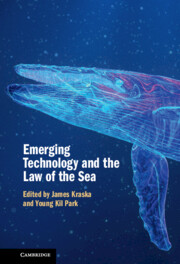Book contents
- Emerging Technology and the Law of the Sea
- Emerging Technology and the Law of the Sea
- Copyright page
- Contents
- Contributors
- Preface
- 1 Emerging Technology and Maritime Boundary Dispute Resolution
- 2 Renewable Energy and the Law of the Sea
- 3 Striking an Equitable Balance under the Biodiversity Agreement
- 4 Small Modular Reactors and Transportable Nuclear Power Plants
- 5 Shipping, Distributed Ledgers and Private Maritime Law
- 6 Maritime Cyber Security
- 7 International Standards for Hull Inspection and Maintenance of Robotics and Autonomous Systems
- 8 Functionalism and Maritime Autonomous Surface Ships
- 9 Artificial Intelligence to Facilitate Safe Navigation of Ships
- 10 Unmanned and Autonomous Warships and Military Aircraft
- 11 Seabed Technology and Naval Operations on the Continental Shelf
- Index
4 - Small Modular Reactors and Transportable Nuclear Power Plants
Published online by Cambridge University Press: 07 July 2022
- Emerging Technology and the Law of the Sea
- Emerging Technology and the Law of the Sea
- Copyright page
- Contents
- Contributors
- Preface
- 1 Emerging Technology and Maritime Boundary Dispute Resolution
- 2 Renewable Energy and the Law of the Sea
- 3 Striking an Equitable Balance under the Biodiversity Agreement
- 4 Small Modular Reactors and Transportable Nuclear Power Plants
- 5 Shipping, Distributed Ledgers and Private Maritime Law
- 6 Maritime Cyber Security
- 7 International Standards for Hull Inspection and Maintenance of Robotics and Autonomous Systems
- 8 Functionalism and Maritime Autonomous Surface Ships
- 9 Artificial Intelligence to Facilitate Safe Navigation of Ships
- 10 Unmanned and Autonomous Warships and Military Aircraft
- 11 Seabed Technology and Naval Operations on the Continental Shelf
- Index
Summary
Small, mobile nuclear technology will power offshore oil gas and rigs, artificial islands and remote strategic areas. Russia has committed to deploying self-contained, low capacity, floating nuclear power plants (FNPPs) to meet the burgeoning energy needs of port cities in the Arctic region. Similarly, China is considering using FNPPs to power its outposts in the Spratly Islands in the South China Sea. Small modular reactors (SMRs) that are placed on board transportable nuclear power plants (TNPPs) are being developed to provide energy for military applications as well, including autonomous and unmanned vehicles. This chapter analyzes three types of TNPPS, their legal status and navigational rights under UNCLOS. It discusses the extent to which the global nuclear liability regime and UNCLOS apply to SMRs and TNPPs, and the different legal avenues that an injured state can seek, including remedies and attachment of liability to states that caused nuclear damage, even where the latter is not a party to any nuclear liability conventions.
Keywords
- Type
- Chapter
- Information
- Emerging Technology and the Law of the Sea , pp. 108 - 140Publisher: Cambridge University PressPrint publication year: 2022



